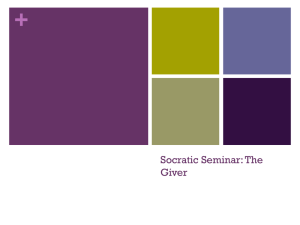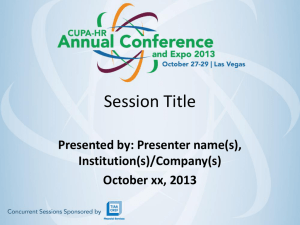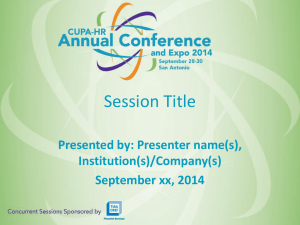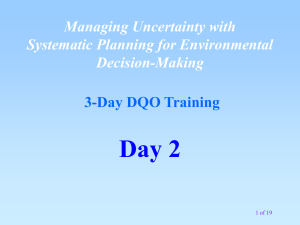Effective use of protocols: Don`t waste my time Bethann M. McCain
advertisement
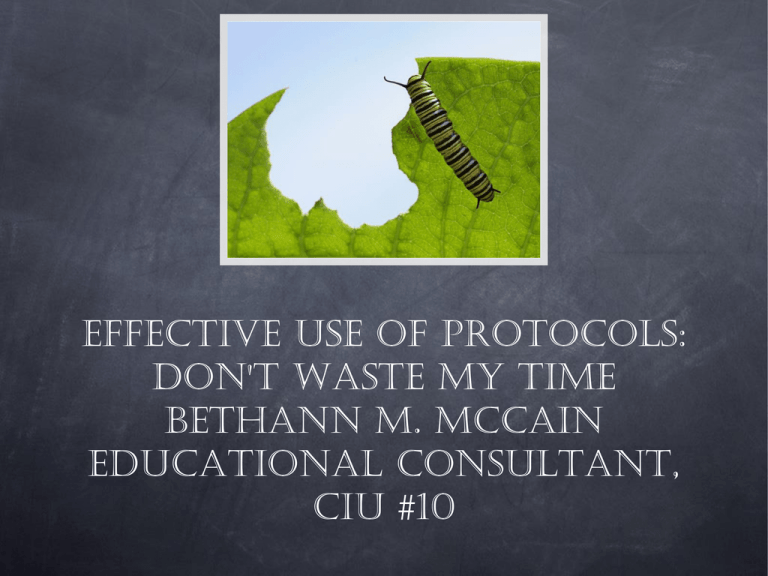
Effective use of protocols: Don't waste my time Bethann M. McCain Educational Consultant, CIU #10 Norms • Start on Time/End on Time • Be fully present • Be respectful and receptive to others • Listen to the speaker What are protocols? Think-Pair-Share: quick write a Tweet- what are protocols? Set of established guidelines that are agreed upon by the team Provide systematic direction to meetings Differentiated and based upon team purpose and team make-up Why do we need protocols? Ineffective Meetings High Expectations Routines Staying on topic Developing a Risk-taking Environment Establishing a common focus/direction Use time effectively Common Uses for Protocols Looking at individual student work or group data Problem-solving Feedback/discussion of observations Structure a discussion around a topic Pushing conversation on a particularly resistant issue Looking at Student Work: 30-Minute Meeting Protocol Before the meeting: Identify “presenter” and provide presenter with a list of what they need to bring Type of student work, copies for team Determine who should be involved in the meeting Establish roles: Note-taker Time keeper Task master Looking at Student Work: 30-Minute Meeting Protocol After the first meeting of the group: 1 minute to review protocols 3-5 minutes for presenter to present information Presenter speaks uninterrupted Other members take notes Presenter poses a question 1 minute for clarifying questions Yes/No or one word answers Looking at Student Work: 30-Minute Meeting Protocol 7-10 minutes for brainstorming ideas Presenter listens and takes notes without responding Other members discuss the “case” 3-5 minutes Presenter offers information obtained from the brainstorming questions and asks clarifying or probing questions in ideas he/she wishes to pursue Wrap-up and Goal Setting (7-10 minutes) Discussion of all members of the group Last few minutes, presenter shares goal, next steps and expected outcome Reflection on process is a good plan as well Consultancy Protocol Longer format of 30-minute meeting protocol Discussion of dilemma- sometimes called “Peeling the Onion” Provides presenter with opportunity to discuss dilemma in a safe, non-judgmental environment Expands the use of probing questions Individuals presenting should not already come with a decided plan, OR with the expectation to change everyone else Book Study Using Socratic Seminar Purpose: begin conversations about new topic or addressing a topic of concern Best used with short chapters or articles Provides all participants with a voice Provides “lead participant” the opportunity to focus the discussion Depending on group size (6-12 is best), can take 30-60 minutes This protocol does not come to conclusion Before meeting Provide participants with text and date of meeting (explain they have to read the text prior) Book Study Using Socratic Seminar Explain to the team the protocol of Socratic seminarLead participant provides guiding question“What are some “hidden rules/hidden curriculum” that we see in our school? Participants are given an moment to process Lead teacher starts at one side of the circle, and asks for responsesLead teacher takes notes on responses; however, does not respond to any comments Participants may pass Lead participant synthesizes information shared and group has open discussion Closure- lead participant synthesizes information and offer next assignment Data-Driven Dialogue • Phase I Predictions Surfacing perspectives, beliefs, assumptions, predictions, possibilities, questions, and expectations • I wonder… My questions/expectations are influenced by… • Some possibilities for learning that this data may present… Data-Driven Dialogue Phase II Observations Analyzing the data for patterns, trends, surprises, and new questions that “jump” out (JUST THE FACTS) • I observe that… • Some patterns/trends that I notice… • I can count… • I’m surprised that I see… Data-Driven Dialogue Phase III Inferences Generating hypotheses, inferring, explaining, and drawing conclusions. Defining new actions and interactions and the data needed to guide their implementation. Building ownership for decisions Guiding questions become deeper and more apt to provide results; HOWEVER, teachers must be ready for this conversation. I believe the data suggests… because… • Additional data that would help me verify/confirm my explanations is… • I think the following are appropriate solutions/responses that address the needs implied in the data… • Additional data that would help guide implementation of the solutions/responses and determine if they are working… Where to start? • Provide choice to your group when possible • “Managed Choice” • • • Individual Work- curriculum work or student work to bring to the group Reading Expansion- learning more about a topic of interest with a group School or districtwide issues to address with the group Where to start? • • • Talk with a group of 3- sharing of goals to be addressedEach person puts 1 post-it note under each category Facilitator organizes post-its by areas of interest • Participants revisit and choose 2 topics • Develop groups It’s All About Teamwork Resources National School Reform Faculty Protocols Read-Write-Think Socratic Seminar Instructional Coaching and Socratic Seminar Brief Protocols from Teachers College Press Creating Collaborative Cultures


